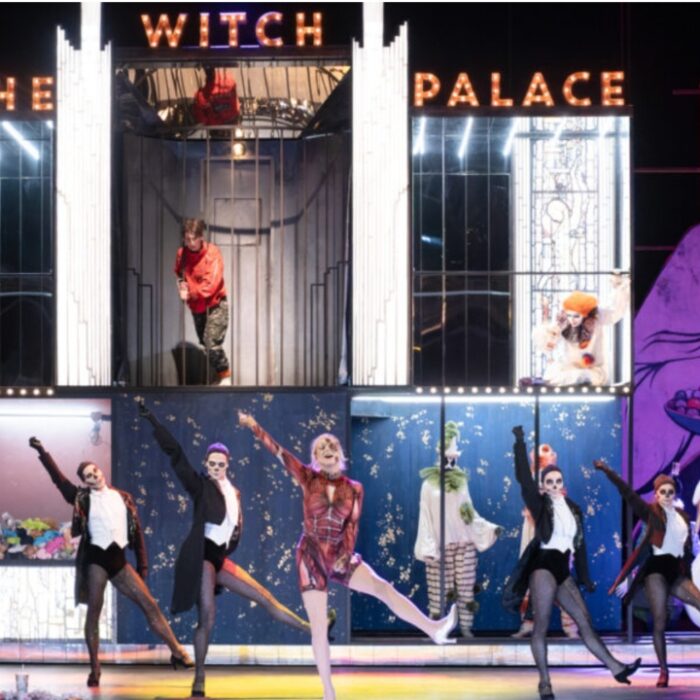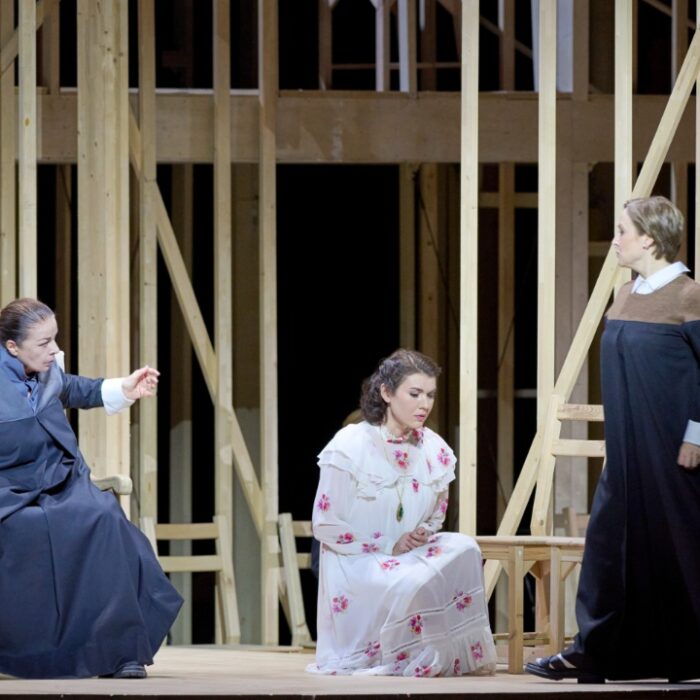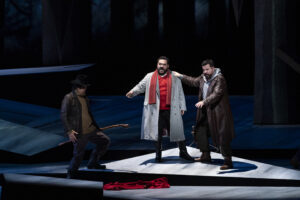
New National Theatre Tokyo 2024-25 Review: Guillaume Tell
René Barbera & Gezim Myshketa Shine in Yannis Kokos’ Vibrant Take on Rossini’s Final Opera
By David Salazar(Photo by Rikimaru Hotta)
The New National Theatre Tokyo is on the rise.
Fresh off its announcement earlier this year that the company would be hosting the 2028 World Opera Forum, the organization has committed to expanding its repertory in recent seasons, taking on increasingly ambitious projects, oftentimes in collaboration with the major opera houses around the world. Over the years, the company has joined forces with the Bayerische Staatsoper, the National Centre for Perming Arts in Beijing, the Opéra de Monte-Carlo, the Salzburg Easter Festival, and the Semperoper Dresden, among others. Most recently, the company co-produced “La Sonnambula” with the Teatro Real de Madrid, Teatro Massimo di Palermo, and the Gran Teatre del Liceu. And all indications are that this will only continue.
At the core of this development is Artistic Director Kazushi Ono, who was also a driving force behind the company’s recent production of “Guillaume Tell,” an original production by Greek director Yannis Kokos, who revealed in a press conference before the show that he found the opera to be a major challenge. He noted that given its length and over-explanation of events, it would be easy to see it as an oratorio. But Kokos also noted that the opera is rife with ideas and themes and that finding the means to express them and the action clearly and confidently was at the forefront of his intentions.
A Wondrous Space
Before I jump into the production proper, I want to make a few comments on the space itself. The New National Theatre Tokyo features three different halls – the Opera Palace, the Playhouse, and The Pit. The Playhouse is reserved for drama and dance, while the 468-seat Pit is far more flexible in what it offers. That leaves the 1,806-seat opera house as the central space for music and specifically, as the name might suggest, opera. It’s a modern venue, its wooden construction dominant throughout, the architectural simplicity allowing the focus to remain on what’s on stage.
Acoustically, it is exceedingly generous and it was clear that the artists both in the pit and on stage were quite comfortable. Musical color is allowed to reign over simple muscularity and strength that is often required at other modern spaces.
Ono, leading the Tokyo Philharmonic in this performance, was able to craft the overture in such a way that the softest of sounds were allowed to contrast with the most brutal. The third section, with its preponderant winds was thus allowed to be more gentle before the explosion of the final iconic section, which was then able to be more forceful, rivaling Ono’s violent outbursts during the storm in the second section of the piece. Particularly notable about that final section was the crescendoing during the violins’ agitated sixteenth note runs. These contrasts also allowed each section to occupy its own dramatic space and provide an effective foreshadowing of the corresponding moments in each of the major acts. The storm in Act four was particularly notable, somehow topping the intensity of the one in the overture and cello solo that opened the opera was matched by the one in Act three accompanying “Sois immobile,” drawing strong musical and dramatical parallels to the two moments.
Throughout the remainder of the night, the orchestra would play a protagonist role in the opera, providing ample support to the soloists without once overpowering them or disconnecting from them (though there were a few moments during ensembles where some entrances were not quite precise). Also notable was how Ono shaped the drama with solid and propulsive tempi throughout. Transitions were seamless and the lengthy opera definitely had a drive that often eludes other conductors who seem to forget that despite all the forward-thinking that Rossini was doing with this music and its romantic breadth, this is still a bel canto opera and not a verismo piece.
The score was unsurprisingly altered to suit the demands of the production and as such passages often cut were reinstated and other passages were cut. In general, the flow of the music was solid overall and I have little to critique here. But Ono and company cut out the repeat of the main melody in the trio between Arnold, Guillaume, and Walter. This major moment for Arnold is accompanied by some of the most gut-wrenching music Rossini ever wrote and to cut even a minute of it was tragic in its own way. Otherwise, this was top-of-the-line conducting and music making from Ono and the Tokyo Philharmonic.
Also elite was Kokos’ production. While the opera doesn’t get presented as much as other Rossini works, the few productions I have seen have often left a lot to be desired. I draw a blank on the Met Opera’s Pierre Audi abstraction from 2016 and the less said about Chiara Muti’s La Scala production, the better. One thing that both of those and Kokos’ approach is the choice to transpose the time period of the supposed legend in which the opera is based and set it in more abstract times. For Muti that was a mélange of time periods and aesthetics, all draped in black, but for Kokos there’s something more concrete, and thus the symbolism is stronger.
Following the opening cello introduction of the overture, the curtain rises on the storm. We are greeted with a forest and suddenly, as the storm explodes with its musical fury, large metallic objects that look like arrows (but feel more like bombs) descend upon the stage. The people of the forest rush around in angst before the calm breaks in and they disperse, the arrowheads hanging over them for the remainder of the piece and returning and remaining later in the opera. Then Guillaume himself runs onstage as the famous brass fanfare kicks off before collapsing to the ground as if overcome and defeated.
Once the overture ends, Kokos manages to paint incredible stage paintings with his blocking with Guillaume and his family on one end of the stage, the townsfolk in the center and Arnold, relegated to the opposite end. As Guillaume shifts about the stage throughout this opening scene, he is often framed on the extreme polar opposite of Arnold, establishing their differing stances and perspectives on the current war. This is mirrored at the end of the opera when all the characters, united by freedom, congregate at the center of the stage. But in the distance, separated and seemingly lacking a place in all this is Mathilde, the last remnant of the previous regime.
Moreover, they are dressed differently, with Guillaume’s collared grey shirt, brown leather jacket, and green pants giving him an earthier feel – he immediately looks like he fits in the dark forest. Arnold meanwhile is fitted in a long grey coat to cover up a red shirt. That red becomes an emblematic color throughout with characters in power often associated with it. It isn’t precise in this sense and Kokos fortunately leaves it up to interpretation with Jemmy, Guillaume’s younger son, also associated with the color in his wardrobe. But we see red worn by Mathilde, Melchtal, and Gesler. It’s notable that by the end of the story, only two characters wear it – Jemmy and Mathilde. Melchtal, the bearer of the red scarf of power, is murdered. Gesler, the military dictator, is defeated. And Arnold embraces his destiny as a rebel and is dressed in a brown leather coat by the end that matches Guillaume’s. Mathilde gets rid of her red coat when she joins the rebels attempting to strip that part of her identity from herself. However, at the end, she still dons a red shawl, a callback to Melchtal’s scarf that is handed over to Arnold and with which he is constantly in conflict with throughout the opera. Meanwhile, Jemmy is still in his red sweater, right in the middle of the stage. It raises interesting questions on how Kokos sees the future generations and whether they are able to sustain the peace achieved by their parents or sink it back into dictatorship. Given the recent political shift to the right across the world, he might be onto something.
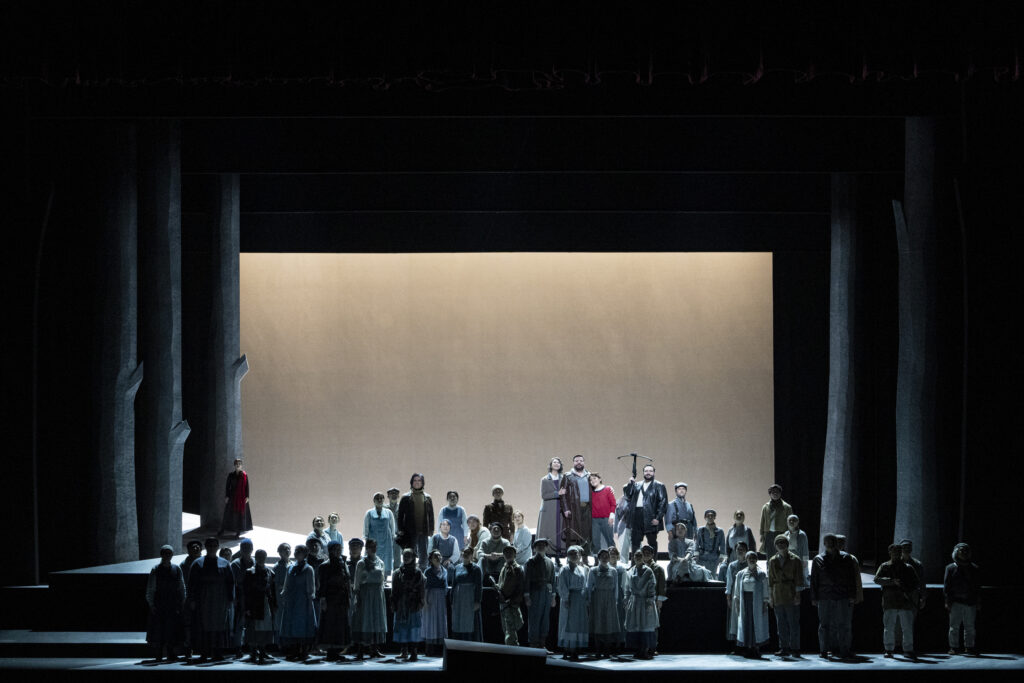
(Photo by Rikimaru Hotta)
Another notable aspect of Kokos’ production is how he uses different visual tools. There are projections, but only ONE projection is allowed full-fledged preponderance. It comes at the climax of the opera when Guillaume faces a storm at sea, the entire stage engulfed in the projection of the sea. It’s powerful and effective because the technology works brilliantly, but also because this is the only moment where it is emphasized. Moreover, it climaxes Kokos’ emphasis on the theme of man vs. nature throughout the production. The forest imagery is preponderant in the first and final act but gets overshadowed by an increasingly twisted stage in Act two and then a full-blown military compound in Act three, man’s hold on nature increasingly potent. Those falling arrowheads further this sense of humanity destroying nature. Finally, at the end of the opera, he brings one other projection to the background – a wrecked modern city that will no doubt remind people of images we have seen in Gaza and Ukraine over the past few years. Kokos said in the press conference that he “allowed himself” this image though he doubted its inclusion throughout the conception of the production. Ending the opera on this image is quite powerful. Not only does it bring into mind the question of Jemmy’s attire and what that might mean, but it reminds us of the toll that freedom brings. The act of rebelling and protecting freedom comes at a cost, often a tragic one.
The theme of man vs. nature is felt strongest in the ballets of the opera, choreographed by Nathalie Van Parys. Act one features a ballet centering on the wedding ceremonies during which there is a central mythic figure performing in a modern style. This performance leads into a dance with three animalistic figures who then face off with the husbands in the three marriages. This simple man vs. nature is resolved in a spirit of celebration. The concept of the dance in this act was great overall, though other moments of choreography felt sloppy by comparison and, in conjunction with the staging, felt messy overall. Safe to say that despite some fascinating blocking choices (keeping Guillaume in the center of the frame for a good portion), Act one was a bit messy in this respect. But the choreography in Act three (and the blocking in general) was brilliant from here on out. Act three’s ballet takes place in Gesler’s camp and serves as a spectacle for him. The three brides return here as prisoners of war and are made to wear animal heads as they get paraded about and tortured by the guards. The dance was visceral and potent in how it told the story of the torture. Moreover, by having the women wear the animal heads it married the idea of Gesler’s authoritarian regime as not only a violation of humanity, but also nature.
On the whole, Koko’s production moved swiftly and vibrantly from scene to scene with astute blocking and clear visuals.
Vocal Warriors
The production’s strengths were accentuated by the two figures tasked with carrying the main drama – tenor René Barbera as Arnold and baritone Gezim Myshketa.
In the title role, Myshketa was muscular as Guillaume throughout the opening acts, his voice powerful and pointed like the warrior he is. There was sturdiness and confidence in everything he sang. For two acts, it might have even come off as monochromatic in approach in how reliable and even predictable it could sound. But when the time for contrast came, it made Myshketa’s initial approach all the more riveting. That contrast came in Act three, where Guillaume, faced with his greatest challenge, almost doesn’t rise to the occasion. We all know the legend of the great archer who manages to shoot the apple on his son’s head in order to save that very child’s life. But Myshketa’s sudden softness in his vocal color, the pianissimo that he found during “Je te bénis en répandant des larmes” as he doubted his own resolve, made us really wonder if he would pull it off. The warrior bared his soul and revealed himself to be so much more. Even the vocal strength he found as he climaxed on “Je suis Guillaume Tell enfin” retained some hesitance in its bite, allowing for “Sois immobile” to come through with the needed urgency, the voice a delicate thread during the initial lines but always yearning and searching for strength. As the aria built, you could sense Myshketa’s baritone crescendoing, the forcefulness so present throughout the first act returning to the forefront, but tinged with pain. The cries of “Jemmy, Jemmy songe à ta mère” exploding into space with a cathartic desperation.
Also notable about this scene was how Myshketa’s physicality differed from the rest of his performance. He was often poised throughout the first two acts, almost always standing and placed in the center of the space or groups. But here, he was relegated to the edges of the stage, his falling to one knee the first time (since the overture) where he looked weak and beaten. His clinging to his son also came off as a man submitting to his fate, furthering the idea that he might not pull off the heroic feat.
On the other end of the spectrum was Barbera, who starts off the opera relegated to the sidelines, literally, and whose initial recitative was a cry of desperation. “Le mien, dit-il, jamais le mien ! Que ne puis-je taire à moi-même” allowed Barbera to establish his musical footprint on the performance, his clear and commanding tenor ringing vibrantly into the space. And it set up a fantastic tête à tête with Myshketa’s Guillaume in their duet. With Myshketa at his trumpeting best, Barbera’s “Ah Mathilde, idole de mon ame” soared with the tenor’s confidence in his upper range, particularly on the high Cs. The passages lies high in the tenor range but seems tailor-made for the Barbera’s voice, judging from the seeming ease with which he executed each passage. A lot of tenors are still warming up at this point and it would be forgivable if they weren’t fully at home to start (I’ve seen it), but Barbera showed no such hesitancy, continuing to build what would be a memorable interpretation.
The tenor showed off his agility and fluidity of line throughout the duet, particularly during “Il est donc sorti de son âme,” throwing off the triplet quarter-eights off with ease and then gliding up on the fifth jumps to G and A with similar bravura and elegance, his voice even from middle to the top and vibrant at the top. But it wasn’t all thrills and brightness as the tenor shaped with tenderness throughout “Doux aveu ! ce tendre langage,” each line caressed as Arnold enjoys a brief and fleeing moment of bliss with his beloved Mathilde. The final section of the duet saw the tenor at his most electric, the voice trumpeting into the space with abandon, capping the duet with a glorious top C.
Then the trio where Arnold discovers that his father is dead. Personally, it is my single favorite moment in the opera (hence my complaining about the cut earlier) as Rossini manages to use the tenor’s range to explore the intensity of pain, the high notes allowed to express something primal and visceral in the context of both drama and melody. But before the Andantino section, Arnold gets a few broken lines to process the information of his father’s death. From “Qu’entends je” to “j’expire,” the tenor made a gradual diminuendo, the final “j’expire” a pure, delicate pianissimo sound. It allowed him to open “Ses jours qu’ils ont osé proscrire” with a thread of sound and elegantly build the line up to the first “Mon père, tu m’as dû maudire,” the forte Gs opening up with a forte sound. But Barbera continued to build through the line, his tenor blossoming up to the high B on “je ne te verrai plus.” But he had even more to offer throughout the remainder of the ensemble, and as he rose to that top A# on “Ciel je ne le verrai plus” he found another gear, his vocal potency arresting in its volume and intense expression. Perhaps having no repetition of the line allowed him to give it more on his single opportunity, but nonetheless, it was a moment to cherish.
Arnold’s big scene comes at the end of the opera with his famous aria “Asile héréditaire” and here Barbera displayed similar fluidity of line, the lengthy high Bb’s delivered with blooming crescendos, the aria itself feeling more and more expansive as if Arnold is holding on to the last remaining threads of his former self. The tenor then put on a virtuosic display throughout “Amis, amis, secondez ma vengeance,” his voice ringing through with rhythmic precision, and the high Cs trumpeted with aplomb. He held the final high C on “aux armes” over the orchestra with fierce muscularity.
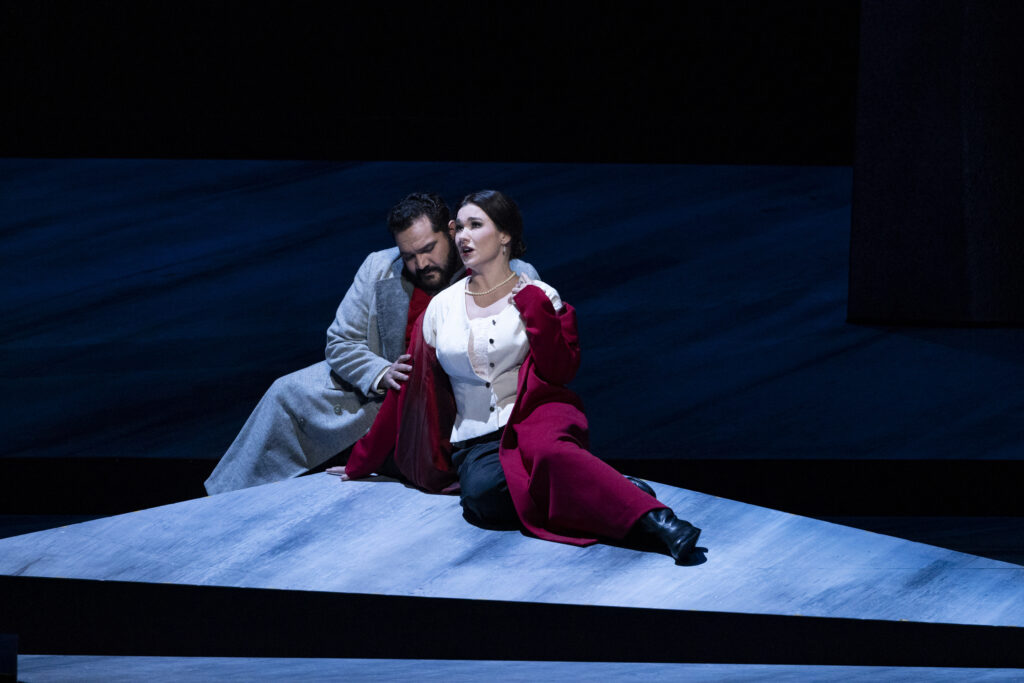
(Photo by Rikimaru Hotta)
Strong Support
From the moment she graced the stage as Mathilde in search of Arnold through the end of the opera where she stood in agonizing pain on the margins of the joyous ensemble, Olga Peretyatko embodied elegance in her stage presence. She had strong chemistry with Barbera throughout their duet as they caressed one another in a show of physical intimacy and tenderness. And she was potent in her Act three appearance when she stormed in to defend Jemmy from Gesler. The Russian soprano displayed similar control in her phrasing, imbuing “Sombre forêt, désert triste et sauvage” with strong musical direction, shaping the opening lines with softer sounds and then using messa di voce on the two A flats in the midst of “que mon coeur peut renaitre à la paix” and then “comme lui tes rayons” during the second section; this effect was time-stopping and deeply effective. The cadenza of the aria ended with similarly poised softer sounds, fading away blissfully. There was a similarly strong connection with Barbera throughout the first portion of their duet, particularly during “Oui, je l’aime et tout me présage,” the two blending their lighter vocal qualities together.
Given the clarity and strong artistic and musical choices she took throughout, there was a slight degree of frustration with the inconsistency and unevenness throughout Peretyatko’s soprano, particularly in her middle and top range which were characterized by coarse and grainy textures. The lower register and her piano singing were where she was at her most consistent, balanced, and smoothest, but passages that required a stronger sound and higher line often sounded labored and featured intonation problems. Her coloratura in “Pour notre amour plus d’esperance” was breathy and she was often overpowered by Barbera during the final portion of their duet. She fared best in the Act four trio where her vocal presence combined well with Junk Saito as Hedwige and Yoko Yasui as Jemmy.
Saito’s mezzo came into its own during that very Act four as she lamented the loss of her husband and son on “Ô protectrice auguste et chère!” her shift from high to low potent.
Yasui’s soprano rode high over the Act one ensemble and she portrayed the youth with bumbling energy throughout. Jemmy is often portrayed a bit older in most productions, but the choice to show him as a preteen ups the stakes and allowed her and Myshketa to bond in a far more tender manner. Her soprano resonated vibrantly as Jemmy implores Guillaume to find strength and was even aggressive in the moment where the character asks to not be tied up.
As Gesler, Hidekazu Tsumaya had a brashness in his singing. His potent bass was paired with a statuesque physicality and a consistent smile, showcasing this imposing figure as masochistic. By contrast, Taiki Tanaka’s Melchtal, while poised, had a softer edge in his bass, providing the two leaders with a strong contrast.
Toshiaki Murakami, as Rodolphe, delivered his moments with supreme aggression, making him almost as formidable as Gesler when the troops raid the stage in Act two and start torturing Guillaume’s people.
Shingo Sudo (Walter) paired well with Myshketa as support for Barbera throughout the trio. He also made the most of his revelation that Melchtal had been killed, almost punitive toward Arnold in his delivery.
Yasuhiro Narita (Leuthold) and Shoji Sato (A hunter) also delivered solid performances in their roles.
A word on the chorus which took some time to get going, but was spell-binding when the ensemble found its stride. Noteworthy passages include the final ensemble of Act two and especially the Act three set-piece in Gesler’s base. Here the ensemble was split into prisoners and soldiers and the prisoners were allowed to soar gloriously, their pain prominently felt. It was an electric moment and one of the standouts of the entire performance.
On the whole, this was an incredible night at the opera. “Guillaume Tell” is a truly challenging work and one that often trips up directors in its translation. Kokos stated during the press conference that among his goals was to make the four-hour opera feel like a one-hour experience. Along with the cast, strong production, and brilliant musicianship from the chorus, orchestra, and conductor Ono, he succeeded.
